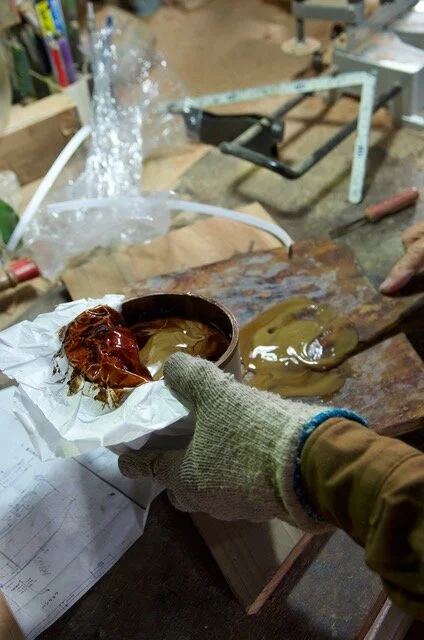Urushi
By Douglas Brooks
People often ask me what Japanese boatbuilders use as bedding or seam compound. Traditionally, many boatbuilders used raw lacquer, urushi, a brown-black substance a bit thicker than molasses with a very bad smell. Lacquer was and is very expensive, so after World War II, boatbuilders quickly abandoned it for waterproof glues that came on the market. Thick glues were the same consistency as lacquer, filling any gaps in the seams before planks were nailed onto the boat. Interestingly, the boatbuilders I’ve talked to didn’t adopt modern glues for their adhesive qualities; they were just interested in a sticky, paste-like substance that was a cost-effective alternative to lacquer.
Nakagawa san using a paste made of lacquer and panko to bed the aft transom seams.
Japanese lacquerware is famous, but the material is widely regarded as dangerous to handle. It causes a severe rash in people who come in direct contact with it. Lacquer, in fact, comes from the Chinese lacquer tree, which is a member of the genus Toxicodendron, the same genus poison ivy, poison oak, and poison sumac belong to. Lacquer artists develop an immunity to urushiol, the toxic oil found in lacquer, with enough exposure, reaching a point where the can handle the material freely without wearing protective gloves.
The small tub of lacquer we used for the honryousen project.
Nakagawa san ordered a small tub of lacquer for roughly one hundred dollars. The lacquer we used came from China, which is now very common in Japan because domestically produced lacquer can cost five times as much. We used about half the tub overall, which means we used about $300 worth of lacquer for the project. To bed the forward and aft transom seams, we mixed the lacquer with panko, a fine flour used to make tempura batter. After a lot of stirring, the mixture becomes very thick and sticky, serving both as a bedding compound and an adhesive. Later, we mixed lacquer, panko, and fine sawdust to produce a stiffer paste, which we used as seam compound for the other parts of the boat.
Raw lacquer out of the tub.
Lacquer mixed with panko.
Nakagawa san had cautioned us about touching lacquer, explaining that a rash usually appears where the skin is thinnest and most sensitive, such as between the fingers and inside the forearms. When we opened the tub of lacquer, he placed a spray bottle of camellia oil on the bench next to it, saying that if we got lacquer on our skin we should spray the oil on it and wipe it off with a rag. Inevitably, we all got lacquer on our skin, so we followed Nakagawa san’s advice and cleaned it off with the oil, thinking nothing of it.
For several days, no rash appeared. It was Nina who first showed a reaction. It appeared on one side of her face and neck and on both of her hands. A day later Douglas woke up with swollen eyes, followed by a rash on one elbow. The rashes continued to spread down the body, from one arm to the other, down the back and belly, to the thighs and eventually our inner knees. As per the advice of friends, we’ve been taking an oral antihistamine and using steroidal cream on the affected areas. But we haven’t seen much improvement yet. Apparently, it can take several weeks for the rash to dissipate.
It was nice to finally use a traditional product central to Japanese boatbuilding, but as we discover new rashes, the thrill is definitely wearing thin. If we ever use lacquer again, we’ll both be sure to wear gloves.







